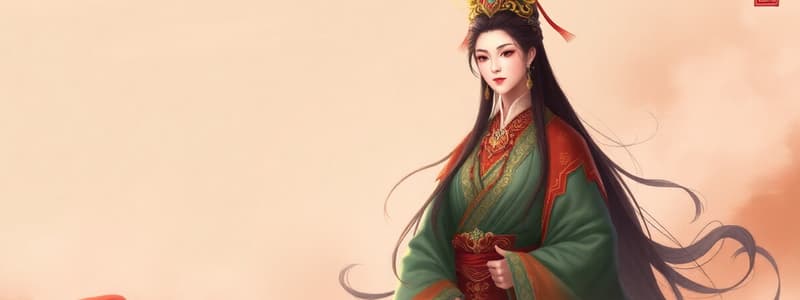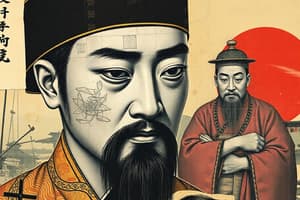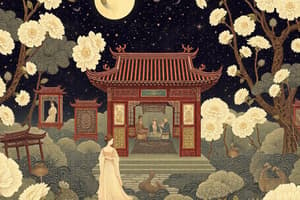Podcast
Questions and Answers
Which of the following best describes the key achievement of the Sui dynasty in relation to China's geography?
Which of the following best describes the key achievement of the Sui dynasty in relation to China's geography?
- Reunifying northern and southern China under a single rule and expanding trade routes. (correct)
- Establishing control over Korea and Japan through naval expeditions.
- Implementing civil service exams to ensure efficient governance.
- Constructing the Great Wall to protect against northern invaders.
Empress Wu Zhao's significance in Chinese history stems primarily from which of the following?
Empress Wu Zhao's significance in Chinese history stems primarily from which of the following?
- Developing new farming techniques that boosted agricultural output.
- Instituting economic reforms that stabilized the Song dynasty.
- Being the first and only woman to rule China as emperor. (correct)
- Leading military campaigns that significantly expanded the Tang dynasty's territory.
How did the use of civil service exams impact the Tang dynasty's governance?
How did the use of civil service exams impact the Tang dynasty's governance?
- Ensured the selection of government officials based on merit and knowledge. (correct)
- Allowed aristocratic families to regain control over government affairs.
- Led to increased corruption and inefficiency within the bureaucracy.
- Reduced the influence of Confucian scholars in the government.
Which of the following demonstrates a key advancement fostered during the Song dynasty that impacted trade and navigation?
Which of the following demonstrates a key advancement fostered during the Song dynasty that impacted trade and navigation?
How did the Song dynasty's approach to trade differ from that of previous dynasties?
How did the Song dynasty's approach to trade differ from that of previous dynasties?
How did new farming techniques contribute to the Song dynasty's economic and social development?
How did new farming techniques contribute to the Song dynasty's economic and social development?
What was the significance of 'foot binding' during the Song dynasty?
What was the significance of 'foot binding' during the Song dynasty?
Which of the following is the most accurate description of the Mongols' lifestyle before Genghis Khan?
Which of the following is the most accurate description of the Mongols' lifestyle before Genghis Khan?
What was the key innovation in Mongol military strategy under Genghis Khan that contributed to their success?
What was the key innovation in Mongol military strategy under Genghis Khan that contributed to their success?
What policy did Genghis Khan implement to foster economic and cultural exchange within his empire?
What policy did Genghis Khan implement to foster economic and cultural exchange within his empire?
What was the 'Pax Mongolica,' and how did it impact trade and cultural exchange?
What was the 'Pax Mongolica,' and how did it impact trade and cultural exchange?
How did the Mongols' approach to conquered territories contribute to cultural diffusion?
How did the Mongols' approach to conquered territories contribute to cultural diffusion?
What Chinese dynasty was established by Kublai Khan, a grandson of Genghis Khan?
What Chinese dynasty was established by Kublai Khan, a grandson of Genghis Khan?
Which technology, used by the Mongols, had origins in China?
Which technology, used by the Mongols, had origins in China?
What factors contributed to the decline and eventual fall of the Yuan dynasty?
What factors contributed to the decline and eventual fall of the Yuan dynasty?
Prior to the Sui Dynasty, which dynasty ruled China?
Prior to the Sui Dynasty, which dynasty ruled China?
What type of trade did the Song Dynasty rely on after losing control of the silk road?
What type of trade did the Song Dynasty rely on after losing control of the silk road?
Which of these dynasties was the shortest in length?
Which of these dynasties was the shortest in length?
What title did Temujin receive?
What title did Temujin receive?
What is the name of new, powerful class that emerged during the Song Dynasty?
What is the name of new, powerful class that emerged during the Song Dynasty?
Flashcards
Sui Dynasty (581-618 CE)
Sui Dynasty (581-618 CE)
Replaced the Han Dynasty; lasted only 30 years.
Sui Dynasty Accomplishments
Sui Dynasty Accomplishments
United North and South China; built the Grand Canal.
The Grand Canal
The Grand Canal
Connected the Yellow and Yangtze rivers; used for trade and travel.
Tang Dynasty (618-906 CE)
Tang Dynasty (618-906 CE)
Signup and view all the flashcards
Tang Dynasty Accomplishments
Tang Dynasty Accomplishments
Signup and view all the flashcards
Tang Dynasty Fall
Tang Dynasty Fall
Signup and view all the flashcards
Song Dynasty (960-1279 CE)
Song Dynasty (960-1279 CE)
Signup and view all the flashcards
Song Dynasty Accomplishments
Song Dynasty Accomplishments
Signup and view all the flashcards
Song Dynasty Trade Changes
Song Dynasty Trade Changes
Signup and view all the flashcards
Cultural Diffusion (Song)
Cultural Diffusion (Song)
Signup and view all the flashcards
Song Dynasty Social Changes
Song Dynasty Social Changes
Signup and view all the flashcards
Foot Binding
Foot Binding
Signup and view all the flashcards
Mongol Background Generalizations
Mongol Background Generalizations
Signup and view all the flashcards
Political Organization of Mongols
Political Organization of Mongols
Signup and view all the flashcards
Genghis Khan
Genghis Khan
Signup and view all the flashcards
Mongol Empire
Mongol Empire
Signup and view all the flashcards
Mongol Fighting Style
Mongol Fighting Style
Signup and view all the flashcards
Genghis Khan (Temujin)
Genghis Khan (Temujin)
Signup and view all the flashcards
Pax Mongolica
Pax Mongolica
Signup and view all the flashcards
Kublai Khan
Kublai Khan
Signup and view all the flashcards
Study Notes
- Summary of the provided text
- Note: The text refers to CE dates unless otherwise stated.
Context Before the Sui Dynasty
- The Han dynasty fell in 220.
- Ancient China's ruling dynasties: Shang, Zhou, Warring States, Qin, and Han.
- More than 350 years passed before the Chinese provinces were reunified under a strong central government.
Sui Dynasty (581-618)
- The Sui dynasty replaced the Han dynasty, beginning in 581
- The dynasty lasted only 30 years.
- Wendi was the first emperor.
- The Sui Dynasty united Northern and Southern China.
- Wendi built the Grand Canal, connecting the Yellow River (Huang He) and Yangtze River.
- The Grand Canal facilitated trade, travel, and communication.
- The Grand Canal was the world's longest canal.
Tang Dynasty (618-906)
- The Tang dynasty lasted 300 years.
- Empress Wu Zhao was the first and only woman to ever rule China.
- Roads and canals were expanded to increase trade and expand the empire.
- Civil service exams ensured the most qualified people worked for the government.
- Schools were established.
- Tang rulers lost control due to invaders and rebellions.
- The Song dynasty replaced the Tang dynasty.
Song Dynasty (960-1279)
- The Song dynasty lasted approximately 300 years.
- The Song Dynasty was smaller but stronger than the Tang Dynasty.
- Advancements included gunpowder for weapons and the compass for sea trade and travel.
- New farming techniques made growing rice more efficient.
- Porcelain was used for various items like china, dolls, and toilets.
- Moveable type using wood or metal blocks, and paper money were invented
- There was a loss of control over the Silk Road, leading to reliance on sea routes.
- Trade occurred with Korea, Japan, India, the Middle East, and Africa.
- Buddhism spread from China to Korea and Japan.
- Old aristocratic families lost power.
- A new powerful class, "Scholar-Gentry," emerged.
- The status of women declined during the Tang and Song Dynasties with the introduction of foot binding.
- Foot binding involved forcing women's feet into tiny shoes.
- The ideal foot size was 3-4 inches.
- "Perfect" foot was called the "Lotus".
The Mongols (1162-1227)
- They were nomadic tribesmen who herded animals.
- They lived in clans (extended families).
- They rode on horseback.
- They lived in yurts, which were portable felt tents.
- The Mongols united in a loose federation.
- Temujin, later known as Genghis Khan, united the Mongols.
- Genghis Khan is a title, not a personal name.
- The Mongol Empire was the largest land empire in history.
- Mongols fought in tribal groups and were loyal to their chief.
- Temujin created an elite group of 10,000 warriors from all tribes loyal to him.
- Mongols fought from horseback and were fast-moving.
- They showed no mercy to opponents but welcomed those who joined.
- Military reforms reorganized the Mongol military.
- Chinese siege technology, including gunpowder, was adopted.
- Positions were based on merit.
- Many artisans and merchants were forcibly relocated to central Asia as part of economic and social reforms.
- A written Mongol language was created.
- Religious toleration was practiced, leading to the spread of Buddhism, Islam, and Taoism.
- A mail system was created.
- Asia was unified.
- The Pax Mongolica was a period of about 100 years of peace after the Mongol conquest.
- Travel became safer.
- Silk Road trade increased.
- Mongols introduced a passport system.
- Harsh punishments were implemented for criminals.
- They unified parts of China, India, Central Asia, and the Muslim Middle East.
- This led to Russian cultural diffusion.
- After Genghis Khan's death, his empire was divided among his successors into four Khanates.
Legacies
- Kublai Khan, Genghis Khan's grandson, established the Yuan dynasty in China.
- Kublai Khan welcomed Marco Polo, the Venetian explorer.
- Gunpowder and cannons were invented in China and used by the Mongols.
- The Mongols used biological warfare to spread disease to enemies, causing the Black Death (Plague).
The Yuan Dynasty
- In 1279, Genghis Khan's grandson, Kublai Khan, completed the conquest of the Song Dynasty.
- Kublai Khan set up the Yuan Dynasty and ruled all of China until his death in 1294.
- During his leadership, the Mongols tried to expand into Vietnam and Japan but failed.
- They controlled Vietnam for a short period of time.
- The Mongols could not reach Japan due to the islands' massive storms.
- Success in ruling China was due to adaptation to the political system, which gained support from many Chinese people.
- In 1368, the Yuan Dynasty fell due to excessive spending on foreign conquests, political corruption, and internal instability. The Ming Dynasty followed.
Studying That Suits You
Use AI to generate personalized quizzes and flashcards to suit your learning preferences.




